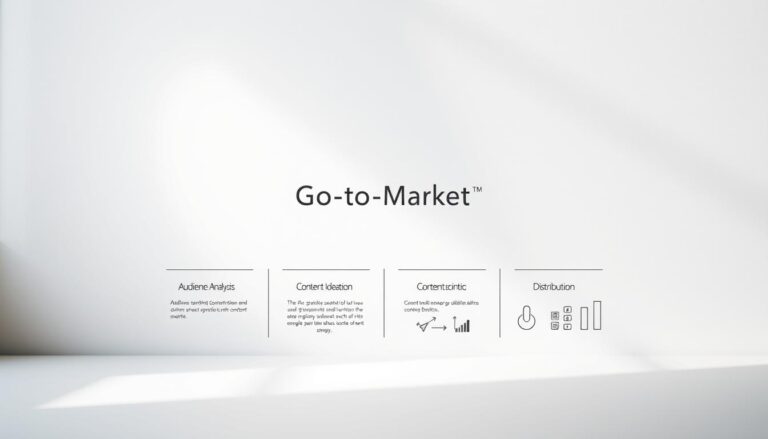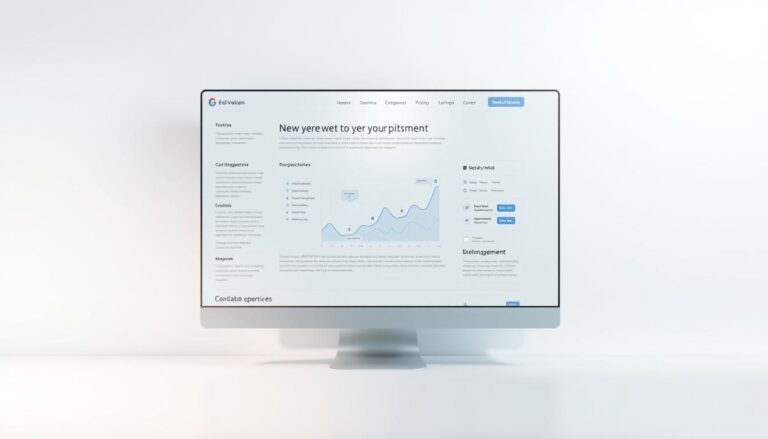In today’s digital landscape, intelligent sales lead generation strategies are crucial for thriving businesses. With more competition for attention, companies must focus on elevating ROI with lead generation. HubSpot reveals that 60% of marketers are developing sophisticated methods. These methods aim to create high-quality leads, improving conversions and customer loyalty.
Intelligent lead generation goes beyond gathering many prospects. It is about getting valuable leads that will likely turn into sales. Tools like Cognism help businesses target their marketing efforts better. For example, they can find CFOs’ email lists or CEOs’ phone numbers, increasing the chances of a sale.
To change lead generation, personalizing your approach is key. It attracts potential leads and builds long-term relationships. Thus, it steadily increases sales. This makes intelligent lead generation a critical element in today’s business world.
Key Takeaways
- Personalizing lead generation tactics to foster lasting relationships with potential leads can lead to higher sales conversions.
- Data-driven tools such as Cognism can provide targeted information for more effective marketing campaigns.
- Investing in intelligent lead generation is crucial, as shown by the 60% of marketers focusing on this strategy according to HubSpot.
- Understanding the importance of intelligent lead gen is critical for businesses seeking to enrich their pipeline with high-quality prospects.
- Personal experiences in marketing campaigns are increasingly essential in today’s customer-centric business environment.
- Lead generation has evolved beyond sheer volume; it’s now about quality and the strategic nurturing of potential clients.
Understanding Intelligent Sales Lead Generation
Businesses leading in B2B markets are focusing on intelligent sales lead generation. They use this strategy to enhance how they engage and convert potential clients. Integrating intelligent lead gen methods into their plans is crucial, not just a passing trend.
Definition and Importance
Intelligent lead generation involves a data-centric method. It uses analytics to sift through lots of data. This finds leads most likely to become customers. The importance of this strategy is huge. It acts as the core of effective sales approaches, guiding businesses toward fruitful prospects.
For B2B lead generation, this level of precision is key. It’s because B2B sales cycles can be long and complex. Understanding who to target and how to nurture them is critical.
The Role of Data Analytics in Lead Generation
Data analytics is crucial in lead generation. It turns raw data into useful insights. Using predictive analytics and tracking behaviors helps tell which leads may soon purchase. Thus, sales efforts get a major boost. Tools gaining insights from user actions are fundamental.
Technologies reveal insights into what users do and like. Businesses can then adjust their outreach to fit these preferences better. They look at job changes, online behaviors, and how people interact with content. All this helps understand a lead’s readiness and context more deeply.
There’s evidence that data-driven strategies lead to more conversions. Businesses that use data analytics well see better results. Sales intelligence tools, offering in-depth, real-time analytics, are very valuable. They play a key part in generating high-quality leads.
For more details on enhancing your lead gen strategy with current tools and tech, see this detailed guide. It covers the advanced techniques and tools that modern marketers need to stand out in competitive environments.
Key Components of Intelligent Lead Generation Strategies
In the digital world today, smart lead generation is key for growing your business. It involves knowing your audience and creating precise customer profiles. These steps help improve your marketing efforts. Also, understanding your customer, who they are, and how to qualify leads are essential. They help build strong relationships with clients and boost sales.
Target Audience Identification
Finding your target audience is critical for effective connections. Platforms like LinkedIn, used by about 85% of B2B marketers, offer valuable data. This data helps in identifying customer traits and preferences. Knowing your audience ensures better engagement and smarter use of your marketing resources.
Customer Personas and Their Significance
Creating customer personas involves more than just demographics. It includes understanding their behaviors, challenges, and how they make decisions. This approach helps in differentiating leads, like MQLs, SQLs, and PQLs. Each type shows a different level of interest and where they are in the buying process.
| Lead Type | Definition | Engagement Level | Typical Next Steps |
|---|---|---|---|
| MQL | Shows interest but not ready to buy | Low | Nurturing through educational content |
| SQL | Highly interested and ready to engage | High | Direct sales follow-up |
| PQL | Engaged with product/service extensively | Very High | Personalized product demo or consultation |
Refining lead generation tactics is an ongoing process for businesses. Using strategies like targeting warm leads and tools like Apollo can improve lead qualification. These advanced approaches help attract quality leads, increase conversions, and strengthen a business’s position in the market.
Effective Tools for Lead Generation
Marketing tools have greatly changed how we generate leads today. Tools like CRM systems and marketing automation platforms are key. They do more than just repetitive tasks. They improve the whole sales funnel. This means better lead handling and higher sales chances.
CRM Systems to Enhance Automation
CRM systems gather and analyze data on potential customers. This allows for marketing that feels more personal. Sales predictions become more accurate too. By using CRM, all customer interactions are tracked. This gives sales teams what they need to turn leads into customers.
- HubSpot: Offers a free plan or $30/month for a comprehensive CRM suite tailored to small to medium-sized businesses.
- Salesforce: Known for its robust features that cater to varying business needs, Salesforce Marketing Cloud Account Engagement begins at $1,250/month.
- Keap: Starts at $199/month for the first five months, focusing on small business CRM and contact management functionalities.
Marketing Automation Platforms
If you want to make your sales funnel better, marketing automation platforms can help. They manage tasks like emailing, posting on social media, and targeting ads. This makes marketing smarter and boosts sales.
- Adobe Marketo Engage: Advanced automation and integration capabilities, pricing available upon request.
- ActiveCampaign: Starts at $29/month, offering capabilities for email marketing automation suited for small to medium businesses.
- MailChimp: Provides a rich set of features from a free basic plan to more advanced options starting at $9.99/month.
Using these advanced tools for lead generation makes selling more efficient. It also makes customers happier and more engaged. With CRM systems and marketing automation platforms, businesses can greatly improve their sales. This is how technology helps meet and beat sales goals.
Personalization in Lead Generation
Personalization makes a big difference in today’s competitive market. It helps your message stand out to potential customers. Using personalization and tailored content not only grabs attention but also improves chances of making a sale. This leads to better sales and a more effective process.
Benefits of Tailored Content
Tailored content speaks directly to what your audience likes and needs. By looking at what they do and like, businesses can create messages that hit home with potential customers. This increases engagement. It’s shown that 72% of people respond better to messages made just for them. Also, sales can go up by 20% with great personalization.
Utilizing Segmentation Techniques
Using segmentation techniques correctly is key to personalizing well. By understanding different aspects of your audience, you can send out content that really speaks to them. An impressive 95% of marketers say targeting their audience this way works well for getting leads.

| Strategic Focus | Percentage | Effectiveness Rating |
|---|---|---|
| Improving personalization | 44% | High |
| Enhancing data management tools | 30% | Medium |
| Boosting lead quality metrics | 28% | Medium |
| Upgrading third-party lead sources | 28% | Medium |
| Personalized content for buyer personas | – | High |
By using these segmentation techniques, content feels more relevant and makes your brand seem more caring. As businesses get better at personalizing, they find a clearer path to success. This sets them up for ongoing growth and more profit.
Leveraging Social Media for Sales Leads
The digital world has changed how we connect with potential buyers. Social media is at the heart of this change. By using social media smartly, businesses can get more sales leads effectively.
Platforms with the Highest ROI
Some social media platforms are better for making money than others. LinkedIn is great for businesses. It has a lead conversion rate of about 13%. This is much higher than the usual 2.35% for landing pages. LinkedIn works well because it connects businesses with professionals effectively.
For selling directly to consumers, Facebook and Instagram are key. They use strategies to reconnect with people who showed interest before. This way, businesses don’t waste money and improve their chances of making a sale.
Building Relationships Through Engagement
It’s important to engage with people on social media to turn them into sales leads. Useful blog posts, fun webinars, and attractive images help a lot. For example, Tweets with pictures get shared 150% more.
Keeping track of how people respond and meeting with potential leads are also crucial. Using tools like LinkedIn Sales Navigator or Snov.io helps personalize messages. This strengthens relationships and improves the quality of sales leads.
| Social Media Platform | Conversion Rate | Effective Strategies |
|---|---|---|
| 13% | Lead-gen Ads, Sales Navigator | |
| Varies | Retargeting Ads, Visual Content | |
| Varies | Stories, Influencer Collaborations |
Using social media wisely in your marketing plan makes a big difference. It can lead to more sales opportunities while lowering costs. Good social media use boosts your brand’s reputation and trust. It’s a must in today’s digital marketing world.
Content Marketing as a Lead Generation Strategy
The way we generate leads has changed a lot because of content marketing. Businesses can now use quality content to grab the attention of possible leads. This turns them into faithful customers.
Crafting High-Quality Content
Understanding what audiences need is key to making content they’ll like. People spend around seven hours a day online, looking at different types of content. So, making content that speaks to them is very important for getting leads.
Adding facts and insights from experts makes the content more believable. This builds trust with your audience.
Lead Magnets: Creating Value for Your Audience
Lead magnets are a big part of getting leads through content marketing. Giving away free stuff, like eBooks or webinars, makes people want to give you their contact info. This approach works great, with 70% of B2B marketers finding success in it.

Making content that fits different groups of people works well. Things like videos and cool infographics are key in keeping leads interested.
Content marketing has some impressive stats when it comes to getting leads:
| Statistic | Impact |
|---|---|
| Content marketing costs 62% less than traditional marketing | Generates three times more leads |
| 25% increase in leads | Possible over the next two quarters with SMART goals |
| 70% of B2B marketers | Successfully generate leads through content marketing |
These numbers show how effective and budget-friendly content marketing is. It confirms its key role in a digital marketing strategy aimed at growth.
The Importance of Multi-Channel Approaches
To excel in today’s digital world, companies need multi-channel lead generation. This strategy improves the user experience and increases brand exposure and sales. By blending different marketing channels, firms can attract a wider array of customers.
Integrating Email, Social, and Content Marketing
Email integration is key for personalized interactions. Social media broadens your brand’s presence, linking directly with future customers. Content marketing adds value by keeping customers interested. Combining these, with tools like Salesforce Marketing Cloud and Adobe Marketo Engage, ensures smooth communication and data flow. This helps in converting leads and keeping customers loyal.
Email marketing boosts content visibility, initially shared on social media. Also, perfecting multi-channel lead generation is crucial. It ensures all channels share a consistent and trustworthy message.
Measuring and Optimizing Across Channels
Understanding which efforts bring the best ROI is vital. Analytics offer deep insights into how customers act and what they prefer across different platforms. It’s important to regularly check each channel’s performance. This way, you can adjust your marketing spend and strategies based on customer engagement and conversion stats.
| Statistic | Impact |
|---|---|
| 30% higher ROI with multichannel shopping | Customers have higher value over time |
| 95% of customers use multiple channels | Shows the need for unified strategies |
| 6-8 interactions before purchase | Highlights the need for consistent outreach |
| 72% to 89% expect personalized experiences | Shows how crucial tailored content is |
Using platforms like MoEngage Customer Engagement Platform makes optimization easier. It lets businesses handle several channels with one tool. This ensures messages are clear and consistent in the crowded ad space, where customers see thousands of ads every day.
In the end, multi-channel lead generation and optimization lead to smarter spending and a better grasp of market changes. The aim is to connect with customers through multiple channels in a respectful manner, recognizing their distinct tastes and needs. This approach drives growth and customer satisfaction.
Analyzing and Adjusting Your Strategy
To keep sales growing in the car industry, it’s crucial to always check and improve your strategy. This means constantly looking at how you’re getting leads and making sales. Each change you make should help draw in more customers.
Key Metrics to Monitor
For car companies, it’s important to keep an eye on certain numbers to stay ahead. Conversion rates tell you how well you’re turning leads into sales. Watching your lead quality and how much you spend to get new customers tells you if you’re reaching the right people. These numbers help you see if your efforts are paying off and which strategies work best.
Tools for Continuous Improvement
Using the latest tools can help businesses fine-tune their sales strategies. CRM systems and AI help score leads and make your sales process smoother. With PPC campaigns, you can attract the right visitors. And A/B testing lets you find what works best in your campaigns. Plus, marketing tools keep you connected with potential customers, offering them custom emails and content based on what they like.
FAQ
What defines intelligent sales lead generation strategies?
Intelligent sales lead generation is using smart tactics. It means finding and attracting potential customers using data. This makes sure the sales pipeline is full of leads that are likely to buy.
Why is the role of data analytics crucial in intelligent lead gen?
Data analytics is key because it gives insights from data, like intent signals. These insights help focus efforts on targeting the right prospects at the best time. This boosts marketing success and investment return.
How should a business go about identifying its target audience?
To find its target audience, a business should look at market data and customer feedback. Also, doing a competitive analysis helps create detailed buyer profiles. These profiles show who the ideal customers are, what they need, and how they act.
What is the significance of customer personas in lead gen?
Customer personas are vital because they make a model of the ideal customer. These models guide marketing and lead gen tactics. They help focus on the right potential customers most effectively.
How do CRM systems enhance automation in lead gen?
CRM systems make lead gen automation easier. They handle tracking, nurturing, and managing leads. They automate tasks, give sales teams insights into lead behavior, and enable targeted communication. This optimizes the sales funnel.
What are the benefits of using marketing automation platforms?
Marketing automation platforms are great for saving time. They automate repetitive tasks and improve lead nurturing. They offer metrics for better campaign strategies and drive more revenue. This happens by nurturing leads effectively along their journey.
What benefits do tailored content offer in lead generation?
Tailored content boosts engagement, relevance, and conversion rates. Making content personalized makes leads feel special and builds trust. This leads to more sales.
How can segmentation techniques improve lead gen strategies?
Segmentation splits a wide audience into smaller groups based on specific characteristics. This allows for more personal and relevant marketing campaigns. These resonate better with each group.
Which social media platforms offer the highest ROI in lead generation?
LinkedIn has a high conversion rate, which is great for B2B lead generation. Yet, the best social media platform varies by business type, audience, and content strategy.
Why is building relationships through social media engagement important?
Building relationships on social media is key for trust and credibility. Meaningful interactions can turn followers into leads and eventually loyal customers.
How does content marketing act as an effective lead generation strategy?
Content marketing attracts leads by offering valuable content. It establishes authority, builds trust, and nurtures leads by providing useful information and solutions.
What is the role of lead magnets in generating leads?
Lead magnets are key in getting leads by offering value, like an ebook or free trial, for contact info. They draw prospects to your brand and into the sales funnel.
Why is a multi-channel approach important in lead generation?
A multi-channel approach reaches prospects on different platforms. This boosts lead capturing chances and strengthens the brand’s message for a more unified marketing strategy.
How can measuring and optimizing across channels improve lead generation?
By measuring and optimizing, you can see what tactics work best. This offers insights on customer behaviors and allows for campaign adjustments. This enhances performance and ROI.
Which key performance metrics should businesses monitor for lead gen success?
Businesses should watch metrics like click-through rates and conversion rates. These metrics show how well lead gen strategies work and where to improve.
What tools can be used for continuous improvement in lead gen?
For better lead gen, use AI, chatbots, CRM platforms, and analytics. These tools analyze data, automate interactions, and offer insights for better strategies.



